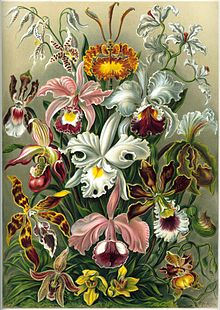
Back Tassonomia delle Orchidaceae Italian Taxonomie en fylogenie van de orchideeënfamilie Dutch Systematyka storczykowatych Polish Taxonomia da família Orchidaceae Portuguese Phân loại họ Lan Vietnamese

The taxonomy of the Orchidaceae (orchid family) has evolved slowly during the last 250 years, starting with Carl Linnaeus who in 1753 recognized eight genera.[2] De Jussieu recognized the Orchidaceae as a separate family in his Genera Plantarum in 1789.[3] Olof Swartz recognized 25 genera in 1800.[4] Louis Claude Richard provided us in 1817 with the descriptive terminology of the orchids.[5] (See External links below). The next step was taken in 1830-1840 by John Lindley, who recognized four subfamilies.[6] He is generally recognized as the father of orchid taxonomy. The next important step was taken by George Bentham with a new classification, recognizing subtribes for the first time. This classification was first presented in a paper that Bentham read to the Royal Society in 1881.[7][8] Then it was published in 1883 in the final volume of Genera Plantarum.[9] The next great contributors were Pfitzer (1887), Schlechter (1926), Mansfeld (1937), Dressler and Dodson (1960), Garay (1960, 1972), Vermeulen (1966), again Dressler (1981).[10] and Burns-Balogh and Funk (1986).[citation needed] Dressler's 1993 book had considerable influence on later work.[11]
Genera Orchidacearum was published in 6 volumes over 15 years, from 1999 to 2014.[8] It covers all of the known orchids, including a description of each genus. It reflects the considerable progress in orchid taxonomy that had been made since Dressler published his classification in 1993. In the 1990s, orchid taxonomy began to be influenced by molecular phylogenetics based on DNA sequences. The first molecular phylogenetic study to include a substantial sample of orchids was published in 1999.[12] The first classification that was based on cladistic analysis of DNA data was published by Chase et alii in 2003.[13]
An update to that classification was published by Chase et alii in 2015.[14] This classification takes a different approach from Genera Orchidacearum, by consolidating many of the tribes and subtribes, and by recognizing very widely circumscribed genera. As of 2015, Orchidaceae was not yet covered in The Families and Genera of Vascular Plants, though most of the vascular plant families had been covered by that time.
The number of genera recognized in the family has varied from one classification to another. In Genera Orchidacearum, many genera were consolidated, reducing their number to 765, smaller than in any previous modern classification.[8] In 2015, Chase et alii merged even more genera, reducing their number to 736.[14]
Useful resources include the World Checklist of Selected Plant Families. Wikispecies (Orchidaceae) closely follows this source with modifications as they become accepted. The Plant List also has lists of genera and species, but no other taxonomic information.[15]
- ^ Haeckel, Ernst (1899). Kunstformen der Natur. Leipzig and Vienna: Verlag des Bibliographischen Instituts. p. 74. Retrieved 18 July 2021.
- ^ Carolus Linnaeus (Carl von Linné). 1753. Species Plantarum, 1st edition, vol. 2, pages 939-954. Holmiae: Impensis Laurentii Salvii (Lars Salvius). (A facsimile with an introduction by William T. Stearn was published by the Ray Society in 1957). (See External links below).
- ^ Antoine Laurent de Jussieu. 1789. "ORCHIDEAE" pages 64-66. In: Genera plantarum: secundum ordines naturales disposita (See External links below).
- ^ Olof Swartz. 1800. "Afhandling om Orchidernes Slägter och deras Systematiska indelning". Kongliga vetenskaps academiens nya handlingar 21:115-139. (See External links below).
- ^ Louis Claude Richard. 1817. De Orchideis Europaeis annotationes. Parisiis, ex typographia A. Belin.
- ^ John Lindley. 1830-1840. The Genera and Species of Orchidaceous Plants. Ridgeways, Piccadilly: London, UK.
- ^ George Bentham. 1881. page 288. In: "Notes on Orchideae". The Journal of the Linnean Society. Botany. 18(110):281-367. (See External links below).
- ^ a b c Alec M. Pridgeon, Phillip J. Cribb, Mark W. Chase, and Finn N. Rasmussen. 1999-2014. Genera Orchidacearum. Oxford University Press. ISBN 978-0-19-850513-6 (volume 1), ISBN 978-0-19-850710-9 (volume 2), ISBN 978-0-19-850711-6 (volume 3), ISBN 978-0-19-850712-3 (volume 4), ISBN 978-0-19-850713-0 (volume 5), ISBN 978-0-19-964651-7 (volume 6)
- ^ George Bentham and Joseph Dalton Hooker. 1883. Genera Plantarum (Bentham & Hooker, 1883) volume 3, part 2, pages 460-488. L.Reeve & Co.; Williams & Norgate: London, UK. (See External links below).
- ^ Robert L. Dressler. 1981. The Orchids: Natural History and Classification. Harvard University Press. ISBN 978-0-674-87525-8. (See External links below).
- ^ Robert L. Dressler. 1993. Phylogeny and Classification of the Orchid Family. Cambridge University Press. ISBN 978-0-521-45058-4. 314 pages
- ^ Kenneth M. Cameron, Mark W. Chase, W. Mark Whitten, Paul J. Kores, David C. Jarrell, Victor A. Albert, Tomohisa Yukawa, Harold G. Hills and Douglas H. Goldman. 1999. "A phylogenetic analysis of the Orchidaceae: evidence from rbcL nucleotide sequences". American Journal of Botany 86 (2): 208-224. (See External links below).
- ^ Mark W. Chase, Kenneth M. Cameron, Russell L. Barrett, and John V. Freudenstein. 2003. "DNA data and Orchidaceae systematics: a new phylogenetic classification". pages 69-89. In: Kingsley W. Dixon, Shelagh P. Kell, Russell L. Barrett, and Phillip J. Cribb (editors). 2003. Orchid Conservation. Natural History Publications, Kota Kinabalu, Sabah, Malaysia. ISBN 978-983-812-078-4. (See External links below).
- ^ a b Mark W. Chase, Kenneth M. Cameron, John V. Freudenstein, Alec M. Pridgeon, Gerardo A. Salazar, Cássio van den Berg, and André Schuiteman. 2015. "An updated classification of Orchidaceae". Botanical Journal of the Linnean Society 177 (2): 151-174. (See External links below).
- ^ "The Plant List: Orchidaceae". 2013. Retrieved 8 December 2018. (Also see External links below).